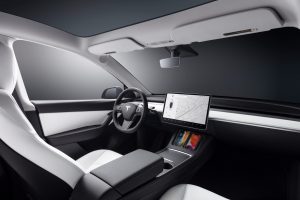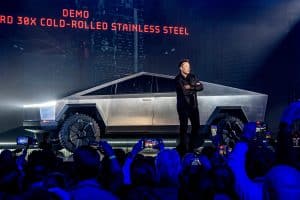A few days ago, the National Transportation Safety Board (NTSB) released its preliminary report for the investigation of the April 17th crash of a Tesla near Houston, Texas. The NTSB’s findings confirm statements Tesla made and show that there was indeed a driver in the seat before the crash. The preliminary report also raises questions about statements made by responders after the crash.
What We Learned From Tesla So Far
The recently released preliminary report gives us a quick summary of what they’ve found so far about the accident. While it’s very informative, we do have to keep in mind that the investigation continues. It all seems to line up pretty well, though, with what Tesla’s VP of engineering told us during the Q1 earnings call:
“Regarding the crash in Houston specifically, we worked directly with the local authorities, NTSB, and NHTSA wherever applicable, and whenever they reach out to us for help directly on the engineering level and whenever else we can support.
“In that vein, we did a study with them over the past week to understand what happened in that particular crash and what we’ve learned from that effort was that autosteer did not and could not engage on the road conditions as it was designed. Our adaptive cruise control only engaged when a driver was buckled and above 5 miles per hour, and it only accelerated to 30 miles per hour over the distance before the car crashed. As well, adaptive cruise control disengaged the cars fully to complete to a stop when the driver’s seatbelt was unbuckled.
“Through further investigation of the vehicle and the accident remains, we inspected the car with NTSB and NHTSA and the local police and were able to find that the steering wheel was indeed deformed, leading to a likelihood that someone was in the driver’s seat at the time of the crash and all seatbelts post-crash were found to be unbuckled.
“We were unable to recover the data from the SD card at the time of impact, but the local authorities are working on doing that, and we await their report.”
Just to clarify, as I did in this other article, they were talking about a test vehicle that Tesla ran to help NHTSA complete their investigation. They determined that lane centering would not activate on that particular road, and they confirmed that traffic aware cruise control (TACC, aka Active/Adaptive Cruise Control or ACC) could not have propelled the vehicle to faster than 30 MPH in the distance the vehicle was known to have driven prior to crashing. Also, the feature wouldn’t work anyway, as the occupants were not buckled in at the time of the crash and ACC won’t work without a seatbelt fastened.
More importantly, though, Tesla was aware that there was evidence that a driver was in the driver’s seat at the time of the collision, which contradicted an early statement made by local law enforcement. Local Constable (an elected law enforcement/court office) Mark Herman said that they were “100% certain” that there was nobody in the driver’s seat.
The NTSB report confirms all of this and gives us some more detail.
The Preliminary Report

The second paragraph gives us some very important information:
“The crash trip originated at the owner’s residence near the end of a cul-de-sac. Footage from the owner’s home security camera shows the owner entering the car’s driver’s seat and the passenger entering the front passenger seat. The car leaves and travels about 550 feet before departing the road on a curve, driving over the curb, and hitting a drainage culvert, a raised manhole, and a tree.”
Most importantly, it’s clear now that the vehicle did indeed have a driver. The owner was seen on camera getting into the driver’s door, and the passenger into the passenger’s door. Neither of them got into the back or were seen vacating their seats in the driveway. After that, the vehicle quickly accelerated, going 550 feet and hitting several things before running into the tree.
While CleanTechnica‘s writers have already dismissed the idea of Autopilot abuse, this is the clearest confirmation yet that Autopilot was not a factor in this accident.
Another piece of information thoroughly rules out TACC abuse:
“The crash damaged the front of the car’s high-voltage lithium-ion battery case, where a fire started. The fire destroyed the car, including the onboard storage device inside the infotainment console (figure 2).”

The level of damage here is not consistent at all with a 30 MPH collision, and that’s the fastest TACC could have brought the vehicle in 550 feet. Clearly, the vehicle was under the full manual control of the driver.
The Local Investigation Should Be Treated With Skepticism For Now
NTSB tells us that there’s a separate local investigation into the accident being conducted by Constable Mark Herman and other local officials, and this is the same guy who told media that his investigators were “100% certain” there was nobody in the driver’s seat that night. Since then, his office has refused to release records detailing how they determined this when video evidence and a deformed steering wheel both later disproved it.
It could be an honest mistake based on limited evidence, as they might not have seen the video or the wheel before the Constable made that statement. If that’s the case, though, I don’t see why their office won’t release public records as required by Texas law. Sure, active criminal investigations can be exempted, but there’s clearly no living person to prosecute, and thus no actual criminal investigation. Hopefully they’ll release that information soon.
At this point, my opinion is that media outlets that were led astray by his initial statements would be smart to take statements from his office with a grain of salt, and compare them to the findings of other investigating entities, until we get a reasonable explanation for the erroneous early statements. [Editor’s note: I would also advise that such media outlets have people who understand how Tesla vehicles work covering Tesla news. It was clear to many Tesla owners very quickly that the statement didn’t make sense and early coverage didn’t match the technology. I’ll write more about this in a separate piece. —Zach]
Remaining Question: How Did The Driver End Up In The Back?
This is a remaining question that we don’t have an answer for yet, and it’s entirely possible that we may never know.
One possibility this preliminary report uncovers is that impacts prior to the final crash could have resulted in the driver being thrown to the back. It says they went over a curb, struck a drainage culvert, and then a raised manhole cover before the final impact with the tree. The curb seems pretty flat in the photos, but we don’t know how big or raised the culvert and manhole covers are.
Other possibilities, like the driver attempting to escape flames, are certainly still plausible. Wilder things I’ve seen people posit, like a third person who fled the scene, are pretty well debunked at this point, though.





